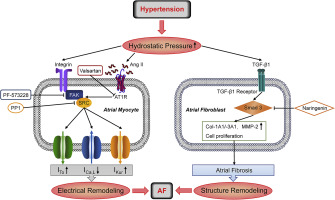当前位置:
X-MOL 学术
›
J. Mol. Cell. Cardiol.
›
论文详情
Our official English website, www.x-mol.net, welcomes your
feedback! (Note: you will need to create a separate account there.)
High hydrostatic pressure induces atrial electrical remodeling through angiotensin upregulation mediating FAK/Src pathway activation.
Journal of Molecular and Cellular Cardiology ( IF 4.9 ) Pub Date : 2020-01-30 , DOI: 10.1016/j.yjmcc.2020.01.012 Xin Li 1 , Chun-Yu Deng 1 , Yu-Mei Xue 1 , Hui Yang 1 , Wei Wei 2 , Fang-Zhou Liu 2 , Hui-Ming Guo 3 , Yang Liu 2 , Zhao-Yu Wang 1 , Meng-Zhen Zhang 4 , Shu-Lin Wu 1 , Fang Rao 1
Journal of Molecular and Cellular Cardiology ( IF 4.9 ) Pub Date : 2020-01-30 , DOI: 10.1016/j.yjmcc.2020.01.012 Xin Li 1 , Chun-Yu Deng 1 , Yu-Mei Xue 1 , Hui Yang 1 , Wei Wei 2 , Fang-Zhou Liu 2 , Hui-Ming Guo 3 , Yang Liu 2 , Zhao-Yu Wang 1 , Meng-Zhen Zhang 4 , Shu-Lin Wu 1 , Fang Rao 1
Affiliation

|
Hypertension is an independent risk factor for atrial fibrillation (AF), although its specific mechanisms remain unclear. Previous research has been focused on cyclic stretch, ignoring the role of high hydrostatic pressure. The present study aimed to explore the effect of high hydrostatic pressure stimulation on electrical remodeling in atrial myocytes and its potential signaling pathways. Experiments were performed on left atrial appendages from patients with chronic AF or sinus rhythm, spontaneously hypertensive rats (SHRs) treated with or without valsartan (10 mg/kg/day) and HL-1 cells were exposed to high hydrostatic pressure using a self-developed device. Whole-cell patch-clamp recordings and western blots demonstrated that the amplitudes of ICa,L, Ito, and IKur were reduced in AF patients with corresponding changes in protein expression. Angiotensin protein levels increased and Ang1-7 decreased, while focal adhesion kinase (FAK) and Src kinase were enhanced in atrial tissue from AF patients and SHRs. After rapid atrial pacing, AF inducibility in SHR was significantly higher, accompanied by a decrease in ICa,L, upregulation of Ito and IKur, and a shortened action potential duration. Angiotensin upregulation and FAK/Src activation in SHR were inhibited by angiotensin type 1 receptor inhibitor valsartan, thus, preventing electrical remodeling and reducing AF susceptibility. These results were verified in HL-1 cells treated with high hydrostatic pressure, and demonstrated that electrical remodeling regulated by the FAK-Src pathway could be modulated by valsartan. The present study indicated that high hydrostatic pressure stimulation increases AF susceptibility by activating the renin-angiotensin system and FAK-Src pathway in atrial myocytes.
中文翻译:

高静水压力通过介导FAK / Src途径激活的血管紧张素上调诱导心房电重构。
高血压是房颤(AF)的独立危险因素,尽管其具体机制尚不清楚。先前的研究集中在循环拉伸上,而忽略了高静水压力的作用。本研究旨在探讨高静水压力刺激对心房肌细胞电重构及其潜在信号通路的影响。实验针对患有慢性AF或窦性心律的患者的左心耳,使用或不使用缬沙坦(10 mg / kg /天)治疗的自发性高血压大鼠(SHR),并使用自体高压将HL-1细胞暴露于高静水压力开发的设备。全细胞膜片钳记录和蛋白质印迹表明,AF患者的ICa,L,Ito和IKur幅度降低,蛋白质表达也发生相应变化。AF患者和SHRs的心房组织中血管紧张素蛋白水平升高而Ang1-7降低,而粘着斑激酶(FAK)和Src激酶则升高。快速心房起搏后,SHR的房颤诱发率明显更高,并伴有ICa,L降低,Ito和IKur上调以及动作电位持续时间缩短。1型血管紧张素受体抑制剂缬沙坦可抑制SHR中的血管紧张素上调和FAK / Src激活,从而防止电重构并降低房颤敏感性。这些结果在经过高静水压力处理的HL-1细胞中得到了验证,并证明了缬沙坦可以调节FAK-Src途径调节的电重构。
更新日期:2020-01-31
中文翻译:

高静水压力通过介导FAK / Src途径激活的血管紧张素上调诱导心房电重构。
高血压是房颤(AF)的独立危险因素,尽管其具体机制尚不清楚。先前的研究集中在循环拉伸上,而忽略了高静水压力的作用。本研究旨在探讨高静水压力刺激对心房肌细胞电重构及其潜在信号通路的影响。实验针对患有慢性AF或窦性心律的患者的左心耳,使用或不使用缬沙坦(10 mg / kg /天)治疗的自发性高血压大鼠(SHR),并使用自体高压将HL-1细胞暴露于高静水压力开发的设备。全细胞膜片钳记录和蛋白质印迹表明,AF患者的ICa,L,Ito和IKur幅度降低,蛋白质表达也发生相应变化。AF患者和SHRs的心房组织中血管紧张素蛋白水平升高而Ang1-7降低,而粘着斑激酶(FAK)和Src激酶则升高。快速心房起搏后,SHR的房颤诱发率明显更高,并伴有ICa,L降低,Ito和IKur上调以及动作电位持续时间缩短。1型血管紧张素受体抑制剂缬沙坦可抑制SHR中的血管紧张素上调和FAK / Src激活,从而防止电重构并降低房颤敏感性。这些结果在经过高静水压力处理的HL-1细胞中得到了验证,并证明了缬沙坦可以调节FAK-Src途径调节的电重构。











































 京公网安备 11010802027423号
京公网安备 11010802027423号